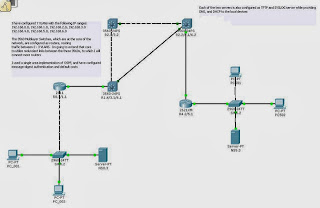Kawawa Chitiya, in this PT scenario, configured 7 VLANs with the following IP ranges:
192.168.0.0, 192.168.1.0, 192.168.2.0, 192.168.3.0
192.168.4.0, 192.168.5.0, 192.168.6.0
The 3560 Multilayer Switches, that are at the core of the network, are configured as routers, routing traffic between 2 - 3 VLANS. He is going to extend that core to utilize redundant links between the three 3560s, to which he will connect more routers
He used a single area implementation of OSPF, and configured message-digest authentication and default costs.
Each of the two servers is a configured as TFTP and SYSLOG server while providing DNS, and DHCP to the local devices
192.168.0.0, 192.168.1.0, 192.168.2.0, 192.168.3.0
192.168.4.0, 192.168.5.0, 192.168.6.0
The 3560 Multilayer Switches, that are at the core of the network, are configured as routers, routing traffic between 2 - 3 VLANS. He is going to extend that core to utilize redundant links between the three 3560s, to which he will connect more routers
He used a single area implementation of OSPF, and configured message-digest authentication and default costs.
Each of the two servers is a configured as TFTP and SYSLOG server while providing DNS, and DHCP to the local devices

No comments:
Post a Comment